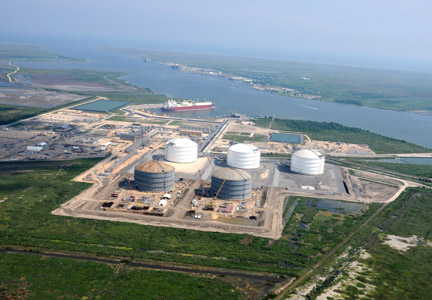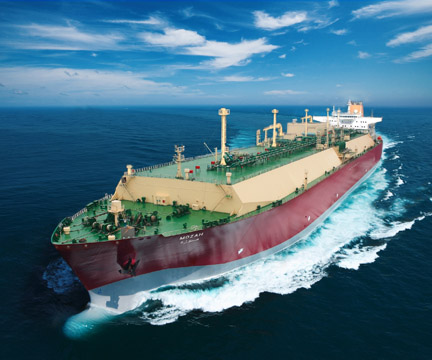Dropping natural gas prices have already dramatically affected profits in the Barnett Shale gas field. But last summer, when a gigantic ship registered to the gas-rich Middle Eastern country of Qatar nosed into a spot at a new port facility at Sabine Pass, just east of the Texas-Louisiana state line, the domestic natural gas industry may have taken an even bigger hit, though the ripples haven’t reached here yet.
 The ship was a liquefied natural gas (LNG) carrier, the first of its size to dock at the new Sabine Pass terminal, one of three LNG facilities to open off U.S. coasts in the last year, with 15 more due in the next few years. And though LNG imports have been part of the fuel industry picture in this country for a couple of decades, that picture is changing dramatically.
The ship was a liquefied natural gas (LNG) carrier, the first of its size to dock at the new Sabine Pass terminal, one of three LNG facilities to open off U.S. coasts in the last year, with 15 more due in the next few years. And though LNG imports have been part of the fuel industry picture in this country for a couple of decades, that picture is changing dramatically.
The bottom line: Natural gas produced in this country is about to face much stiffer price competition from imported LNG. That’s good news for consumers – and bad news for all the North Texas workers and families who put a little or a lot of Barnett Shale money in their pockets every month, courtesy of gas-industry paychecks or royalty checks.
Companies like Chesapeake Energy, Devon, and EnCana, which just seven months ago were recording record profits from gas deliveries in the Barnett Shale and elsewhere in the United States, have seen the price of a million BTUs (British thermal units) worth of gas drop from a high of nearly $13 in August to about $4 at the wellhead today. That drop has led to a dramatic decrease in new well production, leading to layoffs throughout the industry. According to every major Barnett Shale producer contacted, even fewer rigs probably will be in operation in 2010 unless the price of natural gas moves back up into the $6 to $8 range.
“At the current price it’s difficult to drill, produce, and then move the gas to market,” said Alan Boras, spokesman for Canada-based EnCana. “All of us are feeling the pinch. There simply isn’t the demand to raise the price back to what we consider normal levels, and so gas companies have had to scale back their operations – sometimes considerably.”
When natural gas is super-cooled to a temperature of 260 degrees below zero, it liquefies and becomes much more compact. LNG takes up only about 1/600th of the space it would require in gaseous form. That makes it much easier and cheaper to transport.
The United States has imported natural gas for decades – it’s already the fourth largest importer of natural gas in the world, buying mostly from Canada and Mexico. This country has also been importing LNG for about 20 years, primarily from Algeria and the Caribbean nation of Trinidad and Tobago.
In the last few years, however, several factors have combined to make LNG importing much easier. The three new LNG terminals and 15 more in the planning or construction stages – on the East, West, and Gulf coasts – will triple the United States’ capacity for handling such imports. The prices of building LNG carrier ships has dropped sharply in the last decade, and the newest ships use much less fuel to get across the ocean than the older generation of such tankers, leading to a tripling of the worldwide LNG fleet. For those reasons and others, bigger players have entered the game: Egypt, Nigeria, and Qatar – home to the world’s largest natural gas field – have also begun selling to the United States. And they are delivering LNG at rates competitive with what it costs to produce the gas domestically.
Chip Minty, a spokesman for Devon Energy, told Fort Worth Weekly that his company isn’t worried. “We know that Qatar has offloaded a shipment of compressed natural gas in a port in Louisiana that hardly gets any traffic. And we’ve read that they plan on bringing more shipments. But that’s a long way off. We’ll just wait to see what happens … before we speculate on what the impact on the natural gas market might be. It’s not something we’re overly concerned with.”
EnCana’s Boras agreed. “As the price of natural gas rose over the last decade, there has been lots of talk of LNG coming into North America. But given the high cost of capitalization [i.e., building the LNG carrier ships], very little has actually arrived. And given the quality of work and the amount of gas we can produce here in the Barnett Shale and elsewhere in the U.S., we’ve got plenty of gas here. So I don’t think anyone is overly concerned with LNG coming in and competing.”
But those capitalization costs are shrinking. Building an LNG ship now costs about 40 percent of what it did a decade ago. And innovations in the types of motors used to propel the huge craft have reduced fuel costs by nearly half.
Most of the new LNG ports in this country are being built near existing natural gas transportation pipelines, which will help keep the price of imported gas low. In the United States, especially in gas fields like the Barnett Shale, infrastructure costs – getting the rights of way to drill and put in gas-collection pipelines and compressor stations – all work against production companies’ ability to sell their gas cheaply.
Domestic gas producers are hoping that an increase in natural gas usage in the future will help keep them viable.
“We at EnCana and throughout the industry all envision a time when the demand for natural gas will go up – not just in the short term but over the long haul,” Boras said. Producers are hoping, in particular, that natural-gas-burning vehicles will catch on. “We’ll need to change infrastructure in both vehicles and gas stations if we’re going to turn to natural-gas-fueled vehicles on a large scale,” he said. “It will happen, but it will take time.”
The other side of the coin is that European companies are increasingly interested in the shale drilling technology developed here. During the last year or so at least three major European companies have invested billions in U.S. natural gas and oil fields, with an eye to bringing that technology to Europe, which is thought to have massive shale gas deposits.
One of the companies that has already benefited from the European interest is Chesapeake, which received $3.37 billion last year for a share of its Appalachian Marcellus shale project from StatoilHydro, a Norwegian energy company. It was one of the few bright spots for Chesapeake in 2008. Chesapeake’s spokeswoman Jerri Robbins did not return calls seeking comment on this story.
Boras said EnCana officials are not enthralled with the idea of working in Europe. “We did a little drilling in the south of France a few years ago, and it didn’t pan out, so we’re not pursuing those properties any longer,” he said.











